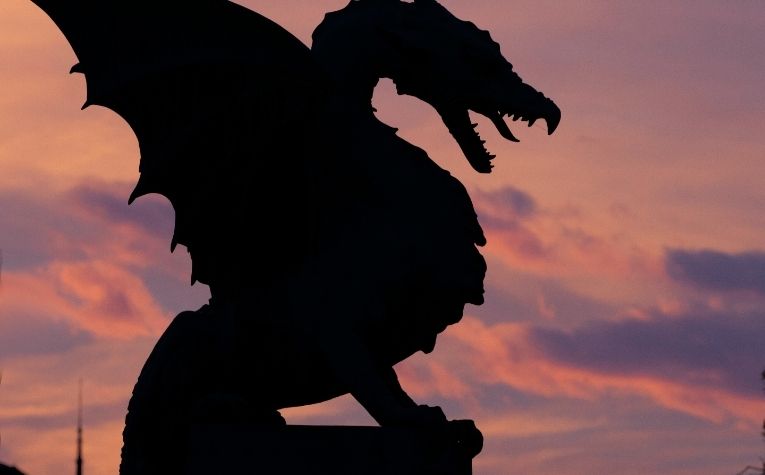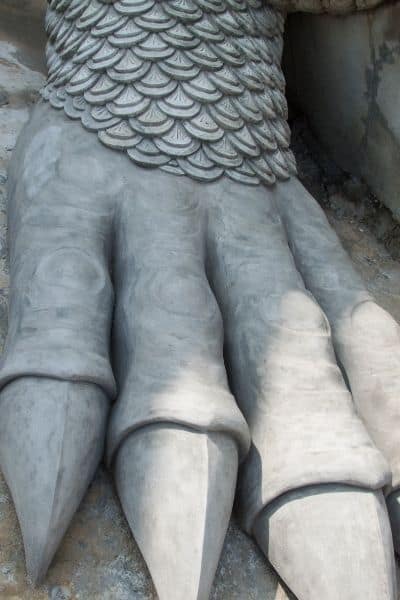Norse mythology is a complex tapestry of myths and stories involving gods, goddesses, giants, dwarves, and of course, humankind.
It is also replete with tales and descriptions of incredible creatures that stretch the imagination, including Odin’s eight-legged horse Sleipnir and the monstrous wolf Fenrir.
Of all the mythical beasts in Norse mythology, dragons may have been the most feared yet revered.
To the Vikings, dragons were powerful creatures that were the embodiment of chaos and destruction.
The mere sight of a dragon portended the arrival of violent and tumultuous times, which is why dragon figures adorned the longships of Viking raiders that terrorized coastlines of Northern Europe.
Like many belief systems throughout history, Norse mythology has strong elements of good versus evil.
A lot of people wonder what Vikings looked like. They even wonder how they wore their hair. See Did Vikings Wear Dreadlocks? to learn more.

But the Vikings also believed in balance, and their myths reflect the constant battle between order and chaos, life and death, and destruction and rebirth.
There are three prominent Norse tales involving dragons, and each conveys a vital message that all Vikings took to heart.
Interested in Norse Mythology? See 14 Great Books on Norse Mythology that explain the gods, heroes, and villains of these ancient stories of Scandinavia.
Fafnir: The Power of Greed
Like so many tales in Norse mythology that have tragic endings, the story of Fafnir the dragon involves the trickster god Loki.
There was a wealthy dwarf king named Heidmar, who had three sons.
All four of them had the gift of shape-shifting, and it was while in the form of an otter that Loki slew Otr for his fur pelt.
To compensate Heidmar for losing his son, Loki offered him a treasure taken from another dwarf named Andvari.

Among the items given to Heidmar was an enchanted golden ring that was cursed to bring its unfortunate owner misery and death.
The curse took hold of Heidmar, who sought to keep its magic from his sons Fafnir and Regin.
Unfortunately for Heidmar, both of his sons were entranced by the mystical powers of Andvari’s ring. Fafnir murdered his father to gain possession of the ring and Heidmar’s riches.
Fafnir then transformed himself into a fearsome, poison-breathing dragon to prevent Regin and all others from taking his treasure.
The Vikings were religious people. Before converting to Christianity, they practiced Norse paganism. See Norse Mythology vs Christianity to learn more.
Sadly for Fafnir, his brother Regin had designs on possessing the ring at all costs and instructed his stepson Siegfried to kill Fafnir and bring him the dragon’s hoard.
Siegfried succeeded in his quest and, upon learning of Regin’s own plan to murder him, killed his stepfather and kept the treasure and the ring (with its curse) for himself.
Thus, the power of greed kept the curse of death alive. [1]

Nidhogg: Dragon of the Dead
The Yggdrasil, which is the Norse tree of life that supports the nine realms of the Viking universe within its branches, is one of the most important symbols in Norse mythology.
Underneath its base, deep within the cold and dark confines of its twisting, outstretched roots dwells the mighty dragon Nidhogg, known to the Vikings as the terrifying “malice striker.”
With scales covering his gargantuan body and features like sharp claws and a pair of horns protruding from its head, Nidhogg is portrayed as a truly fearsome beast.
Nidhogg was closely associated with the dead, specifically murderers, adulterers, and other villainous types, and has been described as feasting on their corpses and stashing them away under its wings.
Aside from presiding over Viking criminals, Nidhogg played a significant role in the Norse people’s view of existence.
The Vikings believed that their universe depended on balance to exist.
What kind of clothes did Vikings wear? What kind of clothes did women wear? What about the men? See The Viking Dress Code: What They Wore and How to learn more.
For there to be good, there must also be evil. If order is to exist, so too must chaos.
On the scales of the Norse cosmos, whatever weighed in favor of law and order was counterbalanced by Nidhogg.
This is why Nidhogg is often described as slithering among the roots of Yggdrasil and constantly gnawing at them.
One of the signs of Ragnarok is the yellowing of the tree of life from Nidhogg’s constant chewing of its life-providing roots, after which the dragon of the dead will emerge from the depths leading an army of giants.
Nidhogg survives Ragnarok to embody the evil that must balance out good in the new world. [2]
Jormungandr: The Dragon of Ragnarok
The third, and perhaps most prominent, myth involving a Norse dragon is the legend of Jormungandr, perhaps best known as the beast prophesied to kill the mighty Thor during the cataclysmic events of Ragnarok.
It was because of this dragon’s fated role that the all-father Odin cast Jormungandr into the vast seas that encircled the realm of humankind, Midgard.
Unfortunately for the Vikings, Jormungandr grew to epic proportions, becoming of such incredible length (Norse dragons were serpent-like in appearance) that it was able to wrap itself around the entirety of Midgar’s coastlines and clamp down on its tail with its mighty jaws.
One of the signs of the Norse apocalypse is to be when Jormungandr releases its tail and embarks on a pre-ordained quest to bring down Asgard, the realm of the gods.
Although ultimately, Jormungandr dies from a fatal blow delivered by Thor’s hammer Mjolnir, the mighty god of thunder walks but nine steps before succumbing himself to Jormungandr’s deadly venom.
In this tale, the dragon represents apocalyptic destruction, not only of the world as the Vikings knew it but also of their beloved gods. [3]
Dragon Symbolism in Norse Mythology and Culture
Although they were closely associated with themes like death, destruction, and chaos, dragons were not considered as inherently evil by the Vikings in the same way that dragons were equated with the devil by Christians. (In fact, the concept of the devil did not even exist in the Norse religion.)
The Vikings believed that the universe was based on a cycle of birth and destruction, and the dragons in their myths represented the destruction half of that equation.
Ragnarok was such an event that even powerful gods like Odin and Thor met their demise in their battles with Fenrir and Jormungandr.
Ragnarok also marked the beginning of a new creation cycle in which life started anew. [4]
Contrary to how dragons were depicted in other parts of Europe, Viking dragons were long and slender and had serpent-like bodies. (This is why Jormungandr was often referred to as the “Midgard Serpent.”)
They often did not have wings, and breathing fire was not a standard characteristic.
The Vikings crafted jewelry with Dragon motifs and included them in drawings and paintings.
Still, perhaps the most striking and emblematic use of dragons was in a manner that was intended to strike fear among the inhabitants of Northern Europe coastlines. [5]
Viking Dragon Ships
Viking longships carried Norse warriors to distant coastlines where their infamous raids would yield them riches and leave behind scenes of utter destruction.
Vessels belonging to high-ranking Vikings were known as dragon ships.
They were distinguished by the unmistakable figure of a dragon’s head on the prow that served to announce their arrival and forewarn of their violent intentions.
While some Viking vessels had a dragon’s head on the prow and a tail on the stern, other dragon ships had a dragon head on both the stem and stern since one of the key features of Viking ships was their ability to be navigated forward and backward.
It is said that the Vikings removed the dragon head from the prow of their vessel whenever they traveled with peaceful intentions so as not to cause unnecessary alarm.
Further, their customs dictated that the dragon head also be removed when they returned home from voyages so as not to anger or disturb spiritual entities in their native Scandinavia.
Such was the power of dragon symbolism in Norse mythology. [6]
Conclusion
The Vikings feared dragons but also recognized their tremendous power and used dragon symbolism to strike fear in the hearts of their enemies and victims.
References:
[1] Source
[2] Source
[3] Source
[4] Source
[5] Source
[6] Source
